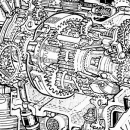Lab:
The Lab is a source of information for Artists and Art Lovers alike. You can find useful information to help develop your career as an artist such as tutorials, interviews, news, and a lot more!

How to write an artist’s CV? Tutorial by Susana López
When I finished my degree in Fine Arts and I began to draft my CV, I realized how different an artist’s CV is from those used in other professions and how little information there is on how to prepare a good artist’s CV.
Throughout the years since I finished my degree, I have met people and done courses that have helped me to write an artist’s CV. Of course, there are several ways to write a good CV, all of which are acceptable, but I would like to share with you a couple of tips that I’ve picked up along the way.
Your CV is like a business card. It’s layout, how the information is organised and it’s content should motivate the reader to want to know more about you and your work.
I suggest keeping the use of fonts and design simple. Avoid over-elaborate or complex designs that distract attention away from the content and use black ink only - CVs are often photocopied and the use of colour tints reduces their quality.
Adapt your CV to each job offer you apply for and always highlight the skills that fit best with the job’s specifications. Always keep in mind the following: what is the purpose of sending this CV? What job are you applying for? What do they need to know about me, my work, etc.?
The ideal length of a CV is no longer than 2 A4 pages. I know how difficult it is to select the most relevant information and get rid of the rest, but I would recommend that you keep this longer version of your CV for your blog, website, and exhibitions etc.
Common mistakes in an Artist’s CV:
Unnecessary information:
· In an artist’s CV you don´t have to write about which languages you speak or your level of IT skills. Include this information only if the job offer specifies it.
· Leave out information about your secondary school qualifications.
CV writing tips:
· Thoroughly check your CVE over before sending it and don’t be afraid to ask your friends and/or family to read it and ask for their opinions.
· Make sure it is easy to read (E.g. Font size, etc.)
· Use only simple fonts.
· I wouldn’t recommend including a personal photograph in this type of CV. Photographs of your work however, may be included in an annex.
· Your age – there are differences of opinion surrounding this point. In Europe, we always include our date of birth however, in the USA they prefer not to as a means to avoid age discrimination. I personally always prefer to add my date of birth.
CV Structure: what to include in an artist’s CV?
- Name and contact details.
- Experience in chronological order (most recent first).
- A selection of relevant information.
Name: Also include your place of birth and place of residency.
Contact details: email, telephone, webpage, blog, profesional profile on facebook, twitter, etc.
Education: Only include your most relevant education such as: degree, postgraduate master, PhD, etc. anything related to your professional practice.
Individual exhibitions: Year, title, gallery, city, country.
E.g. 2012, ‘Chopsticks’. Photo Show in PhotoarteKomite. Bilbao
Always add the name of the curator if possible.
Joint exhibitions: Year, title, gallery, city, country.
E.g. 2013, ‘The Line of Beauty’, Irish Museum of Modern Art, Dublin
It is important to specify if you’re talking about an individual or group exhibition. Some artists like to order all of their exhibitions by year, however I prefer to differentiate between individual and group shows, and order each of these lists accordingly in chronological order (most recent first).
If you have taken part in a large number of exhibitions, select only the most interesting and relevant ones and avoid including any exhibitions you may have done in pubs, restaurants, etc.
Awards: Provide details of any prize you have been awarded or shortlisted for.
E.g. 2010 Amsterdams Fonds voor de Kunst_video installation during Julidans Festival 2010_Amsterdam_NL
Residencies: Include year and name of residency programme and also include one brief sentence outlining the type of work you carried out during your time there.
E.g.Residencies
2005 Hill End Bathurst Regional Gallery, NSW
2004 The Gunnery New South Wales Ministry For the Arts, Sydney
2003 Cite Internationale des Arts Paris, France
2002 St Vincents Hospital Melbourne
Publications: List any articles, books, academic papers, etc. that you have written or that have mentioned you or your work and include the title of the essay/article, name of the publication, Issue/Volume number and date so it can be looked up.
E.g.2001 A Creative Challenge: Mixed Media, published by Hong Kong Arts Centre / Hong Kong
Collections: List any private or public collection your work belongs to and include the year of purchase and name of the collector/foundation/company, etc.
Gallery exhibits: List any relevant experience you have gained and where and when you took part in specific projects.
Bibliography.



